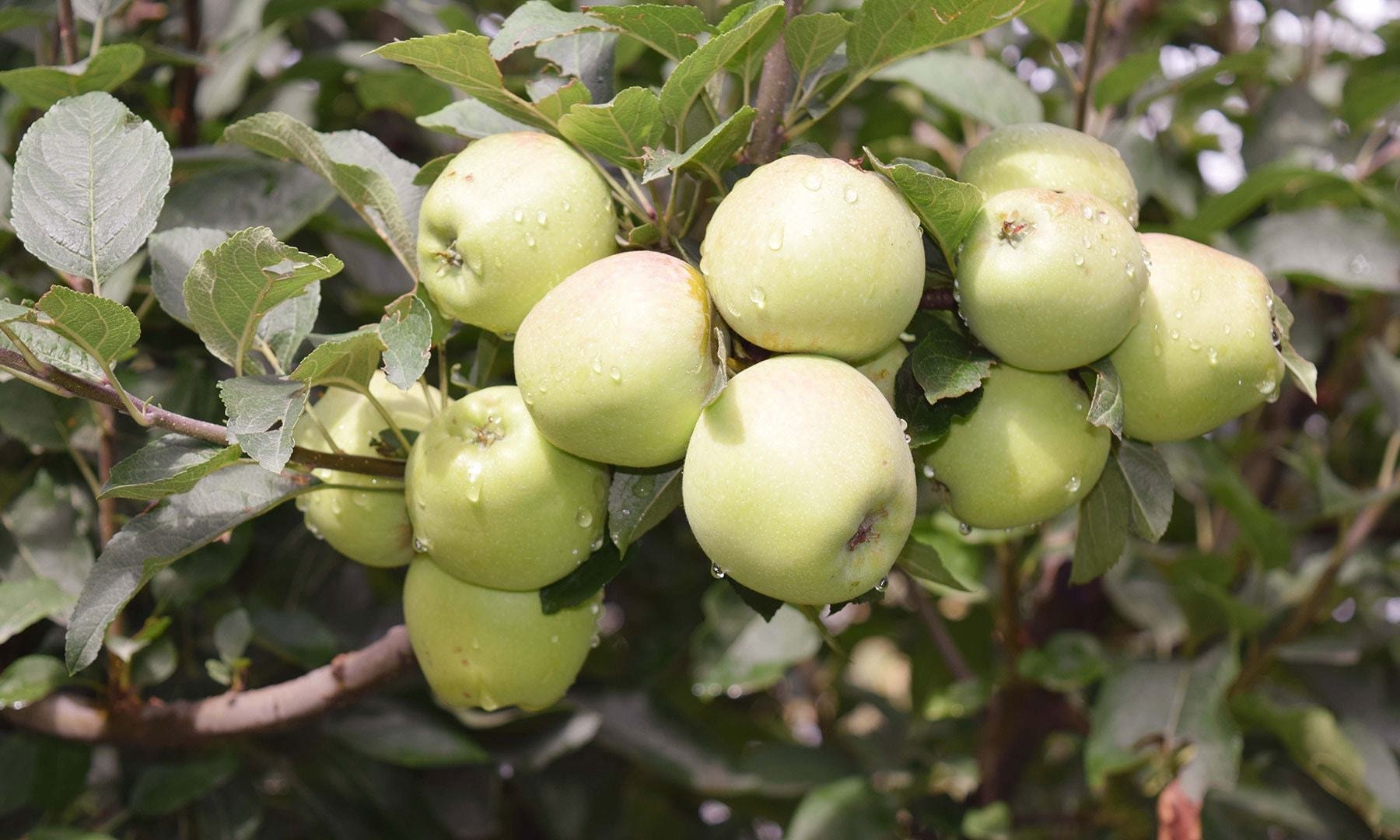Located just 38 kilometres away from Mingora, the central city of district Swat, Gwalerai is one of those few villages which produces 18 varieties of apples, thanks to its temperate climate in summer. The apple produced here is well known and in great demand, not only in Pakistan but across the world alike. It is famously known as ‘the apple of Swat’.
Comprising over three square kilometres, Gwalerai is located between the banks of two rivers, Markarkat and Arnohai. Like other lush green villages of Swat, Gwalerai grows all kinds of crops, from spinach, wheat, millet to fruits like persimmons, apricots, plums, peaches, pears, pomegranates and grapes. But the fruit it is most famous for is its apple.
 |
A view of Gwalerai from Labatt hill. |
 |
Gwalerai bazaar. |
 |
An old house in the village. |
The apples grown here have various names, some local, some national. According to Bacha Nawab, a local agriculture expert in Gwalerai, the Aamri, Shana and Sheesha type of apples can be stored up to one year at any place, with little to no proper care. They are the perennially occurring type, unlike the other fifteen varieties i.e. Harri, Fransisi (French), King Star, Kashmiri, Basooti, Sota, Kala Kola, Real Gala, Samret, Gala Mass, Mondi Gala, Gajra, Red Chips, Malochi and Watani.
In general, the ‘French’ apple is liked by all and sundry of the area.
The village also grows around nine different varieties of ‘Shaftaloo’ (large peach).
Another agriculture expert, Abdul Qadeem, has been transplanting and trimming various fruit trees in the orchards of the village for over 50 years. According to him, the soil here is conducive to all kinds of fruits.
“Normally, apple trees bear fruit in the summer season. But now, the American apple (called ‘Amriki Sayb’ in local language), is one such fruit which is procured in winter. Each type of apples has its own different taste, but the French apple is unique among all,” he says.
 |
A branch of Fransisi apple tree full of fruits. |
 |
A corner of Gwalerai village. |
 |
Gwalerai’s cloud-covered mountains are called ‘Awarai’ by locals. |
The village hosts a small population of 1165 people, most of them farmers. According to Abdul Qayyum, the total number of all the orchards, big and small, would be around one hundred. The products – like the Fransisi, Real Gala and Samret apples, among others – are exported to foreign countries as well.
The Samret apple ripens before all other apples in August. According to Abdul Qayyum, there are four kinds of Samret, locally known as Glassi, Palna Samret, Kach and Manda Gala.
“Among these varieties, only Manda Gala has the distinction of having the capacity to develop one flower usually into twelve apples, which are rubicund in colour. Usually, one plant of Manda Gala recovers the cost of the entire orchard, but it is not easy to look after it.”
 |
A beautiful view of an orchard located in middle of the village. |
 |
View of an orchard of Fransisi and Samret apples. |
The orchard owners of this area, after harvesting Samret in the early days of August, store the fruit in the same orchards, during which, the harvest is covered with large plastic sheets and fodder. Then the packing process begins. By the end of August, Gwalerai apple is available in the fruit market of Mingora city, where it’s handed over to owners of the Mingora fruit market for Rs15 to Rs20 per kg. From there, it is transported to the country’s large fruit markets.
Bigger cities possess the cold storage facility, where the apples are stored for weeks, and after there's a shortage (such as during Ramazan), are sold to consumers for prices as high as Rs100 to Rs120 per kilogram.
Bacha Zada, a villager of Gwalerai, strongly objects to this price disparity. According to him, even today, the Gwaleri apple has the same price that was fixed in 1985 in the Mingora fruit market. In the past 30 years, the price of every other commodity has skyrocketed, but the rates of Gwalerai apples never rose.
The concerned officials should take action in this regard, so as not to compel the farmers to give up their farming and turn their orchards into commercial plazas, like the ones we see blooming in all our cities.
 |
A path between apple orchards leading to river. |
 |
View of an orchard of Watani and Fransisi apple. |
Up till just ten years ago, 95 per cent of Gwalerai could be seen covered with apple orchards of varying sizes. But that's not the case anymore. Today, people prefer farming to the more profitable business of setting up shops and constructing markets and plazas.
Shaharyar of Swat Shirkati Council (a non-governmental organisation) says that if cold storage facilities are introduced in the area, then agriculture may start becoming the priority of the locals again. Otherwise, the puny profits from a year-long effort of farming will keep discouraging it.
He also complains of the apple hoarding by the major buyers of Gwalerai's produce across Pakistan.
 |
A 'large peach' tree. |
 |
Another peach tree. |
Shaharyar is also of the view that seeing as the village is located at the confluence of two rivers, the construction of micro-hydropower plants along with juice extraction plants and a cold storage facility will not only benefit the owners of the orchards but also boost the area’s fruit harvest. Further, the apples could be transported to factories which produce fruit-based products like jams and marmalades.
“All this is not so difficult to accomplish, but an awareness campaign needs to be launched for owners of the orchards,” he recommended.
 |
Trees of Fransisi apples and local plums are face to face. |
—All photos by author
Translated by Zamir Hussain Laghari from the original in Urdu here.